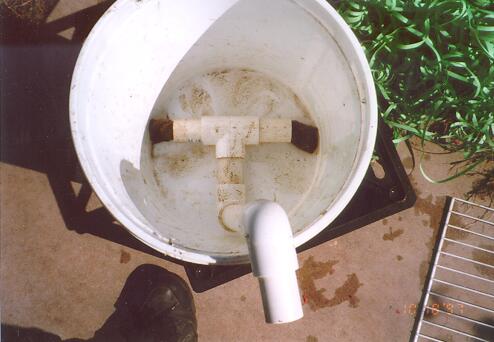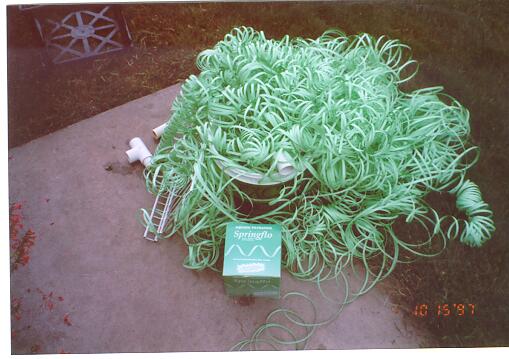How to build an excellent filter.
Last spring I put together a filter for a 500 gallon goldfish pond I had been having trouble keeping clear with a small inpond gravel filter. I was using this pond as a hospital tank and it would stay dirty and green. The year before I had put a small version of a barrel gravel filter in the tank and it had worked ok, but when spring came the tank turned green and dirty and wouldn't clear up. Last year a friend of mine, Gary Cryer of Koi of Oklahoma told me about a filter he was sometimes recommending for small ponds. I decided to try something very similar and what follows is what I came up with..
I used a five gallon bucket crammed full of PVC ribbon filter media. I had tried this media on a friends pond the year before but we didn't install it correctly and it didn't work very well, the biological function worked well but it did a poor job of mechanical filtration, so the water was always a little turbid. I went to the AKCA seminar in Denver and spoke to some of the dealers that sell ribbon media and I think I found out why it didn't work. Basically, we were just pumping the water through it too fast and forcing the fine particles right on through the media. We had just filled a barrel up with the ribbon and let it assume it's natural volume and were pumping up through it. I am assured that it will work if you allow enough volume and keep the water velocity down, but I'm not sure how slow.
So what I did was to cram as much ribbon as I could into a 5 gallon bucket, put a lid (screen) on it and pumped through that with a 500 gallon an hour pump (more on the pump later). First I made a water distribution manifold using 1 inch PVC pipe and put it in the bottom of the bucket. The first picture below shows this. On the under side of the pipe there are several 3/8 inch holes spaced about one inch apart. This is important so as to achive even water distribution in the bottom of the bucket. Then I filled the bucket with Ribbon.


This next picture shows the bucket full and overflowing with ribbon. And the box the ribbon came in. There are several brands of this ribbon, Springflo is just what I used for this filter. These different brands have slightly different characteristics and some perfer one type over the other. What I have found and have talked to others who agree, the ribbon shown in the picture, Spring-flo is not the best to use this way. Much better results have been achived using "Bio-fill" brand, you can get this from Aquatic Eco Systems, on line at www.aquaticecosystems.com. Search for "Bio-Fill", Part no. BF250. The standard package size is a real tight fit in a five gallon bucket, but just cram it in there. The screen I used for a lid is a piece of metal closet shelving that I got at the Home Improvement Center. I drilled a few holes around the top of the bucket and tied it down with plastic ties. There are many ways the top can be fastened down, just remember there will be considerable pressure on it from the ribbon trying to expand out of the bucket.

This is what bio-fill looks like.
Below is picture of the filter with pump and plumbing attached. I sit this assembly into the pond exactly like this. I sit the bucket up on the milkcrate because that gets the overflow right up at the surface of the water, I place an airstone suppiled by an aquarium air pump under the bucket, this will keep the pond bottom clean there. The way this is setup provides very little water movement in the pond, the air stone will help with that.. This filter can be placed anywhere in or out of the pond, place it at the top of a water fall if you want. In that case some aesthetic enhancements would be nice, some vegetation perhaps. In some cases I just sit the bucket on the bottom. The only thing, it is better to position the intake as far as possible away from the return and at the deepest point in the pond, this will give the best water circulation in your pond, good water circulation is important, you want no backwaters in your pond where the water can sit and go anaerobic on you.

The pump I use for this is a 500 gallon/hour (U.S.) Mag-Drive by Danner Mfg. They are availble from many sources, cost about $50 U.S. mail order or up to $80 U.S. retail. Quite a disparity there I know. They are excellent pumps, completly rebuildable in a couple of minutes. Use almost no electricity, somewhere around 30 watts. They can be installed submerged or inline (out of the pond). They are available in sizes from 250 to 1200 gallons/hour (U.S.) pump rate. You can buy these from Aquatic Eco Systems online or do a google search on Danner Pumps.
This is a filter intended to replace all the bucket filters with filter matting in them that just drop in the pond. Those things are a pain in the neck, heavy, hard to clean, they clog up in just a few days (or less) and really don't do a very good job of filtering your water.
If you wanted to get fancy, you could cut a hole and run the water through the side of the bucket and do away with the riser I show going up and over and down to the bottom of the bucket. If you use a bulkhead fitting in the side and do that you will get a little better flow from the pump. Every time there is a change of direction in plumbing you lose a little efficiency from your pump.
If you are in need of a filter for a small pond, give this a try, it works.